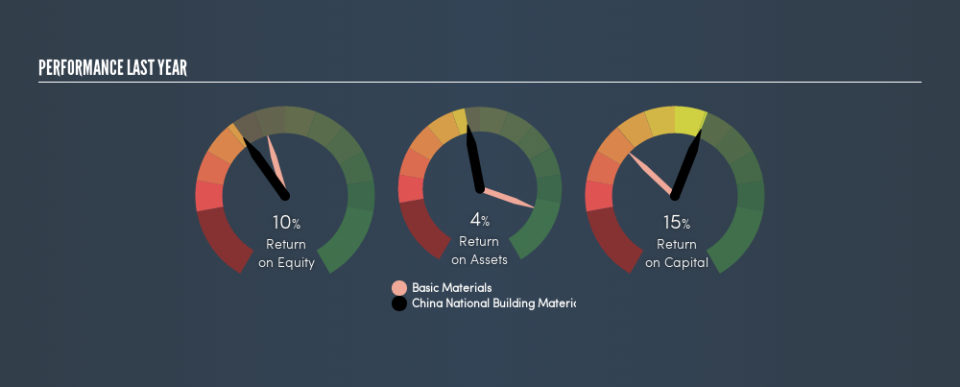China National Building Material Company Limited’s (HKG:3323) Investment Returns Are Lagging Its Industry

Today we'll look at China National Building Material Company Limited (HKG:3323) and reflect on its potential as an investment. In particular, we'll consider its Return On Capital Employed (ROCE), as that can give us insight into how profitably the company is able to employ capital in its business.
First, we'll go over how we calculate ROCE. Next, we'll compare it to others in its industry. Last but not least, we'll look at what impact its current liabilities have on its ROCE.
What is Return On Capital Employed (ROCE)?
ROCE measures the 'return' (pre-tax profit) a company generates from capital employed in its business. Generally speaking a higher ROCE is better. Overall, it is a valuable metric that has its flaws. Author Edwin Whiting says to be careful when comparing the ROCE of different businesses, since 'No two businesses are exactly alike.'
So, How Do We Calculate ROCE?
The formula for calculating the return on capital employed is:
Return on Capital Employed = Earnings Before Interest and Tax (EBIT) ÷ (Total Assets - Current Liabilities)
Or for China National Building Material:
0.15 = CN¥33b ÷ (CN¥437b - CN¥214b) (Based on the trailing twelve months to December 2018.)
So, China National Building Material has an ROCE of 15%.
View our latest analysis for China National Building Material
Is China National Building Material's ROCE Good?
ROCE can be useful when making comparisons, such as between similar companies. We can see China National Building Material's ROCE is meaningfully below the Basic Materials industry average of 19%. This performance is not ideal, as it suggests the company may not be deploying its capital as effectively as some competitors. Separate from China National Building Material's performance relative to its industry, its ROCE in absolute terms looks satisfactory, and it may be worth researching in more depth.
In our analysis, China National Building Material's ROCE appears to be 15%, compared to 3 years ago, when its ROCE was 6.4%. This makes us think about whether the company has been reinvesting shrewdly.
When considering this metric, keep in mind that it is backwards looking, and not necessarily predictive. ROCE can be deceptive for cyclical businesses, as returns can look incredible in boom times, and terribly low in downturns. ROCE is only a point-in-time measure. Since the future is so important for investors, you should check out our free report on analyst forecasts for China National Building Material.
China National Building Material's Current Liabilities And Their Impact On Its ROCE
Short term (or current) liabilities, are things like supplier invoices, overdrafts, or tax bills that need to be paid within 12 months. The ROCE equation subtracts current liabilities from capital employed, so a company with a lot of current liabilities appears to have less capital employed, and a higher ROCE than otherwise. To counter this, investors can check if a company has high current liabilities relative to total assets.
China National Building Material has total assets of CN¥437b and current liabilities of CN¥214b. As a result, its current liabilities are equal to approximately 49% of its total assets. With this level of current liabilities, China National Building Material's ROCE is boosted somewhat.
What We Can Learn From China National Building Material's ROCE
With a decent ROCE, the company could be interesting, but remember that the level of current liabilities make the ROCE look better. There might be better investments than China National Building Material out there, but you will have to work hard to find them . These promising businesses with rapidly growing earnings might be right up your alley.
For those who like to find winning investments this free list of growing companies with recent insider purchasing, could be just the ticket.
We aim to bring you long-term focused research analysis driven by fundamental data. Note that our analysis may not factor in the latest price-sensitive company announcements or qualitative material.
If you spot an error that warrants correction, please contact the editor at editorial-team@simplywallst.com. This article by Simply Wall St is general in nature. It does not constitute a recommendation to buy or sell any stock, and does not take account of your objectives, or your financial situation. Simply Wall St has no position in the stocks mentioned. Thank you for reading.

